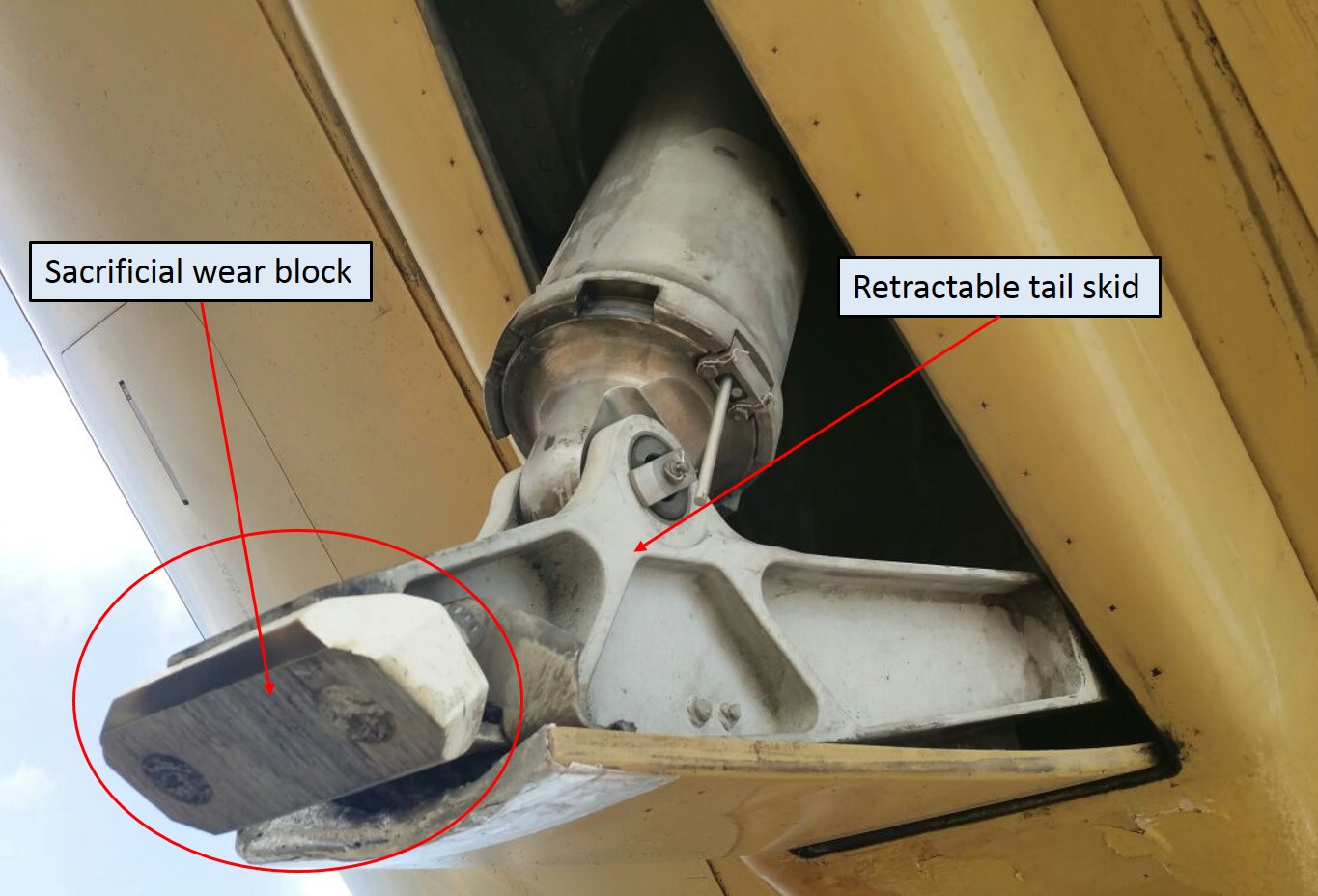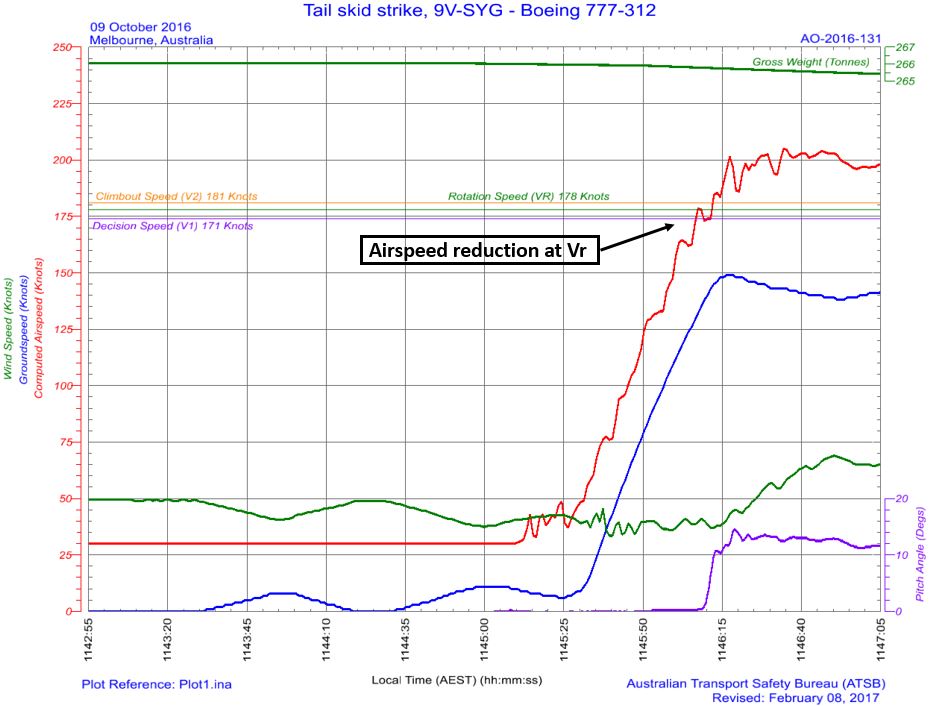What happened
On 9 October 2016, a Singapore Airlines Boeing 777-312 aircraft, registered 9V-SYG (SYG), was operating a scheduled passenger service from Melbourne Airport, Victoria, to Singapore with two flight crew, 16 cabin crew and 261 passengers.
The crew arrived on board the aircraft and commenced their standard pre-flight procedures. The captain was operating as pilot flying (PF) and the first officer operating as pilot monitoring (PM).[1] The captain commenced the flight deck pre-flight procedures while the first officer performed the exterior inspection. After completion of the external inspection, the first officer commented to the captain that while on the apron ‘they had difficulty walking straight due to the strong wind’. The flight crew received the automatic terminal information service (ATIS)[2] using the aircraft communication addressing and reporting system. ATIS W advised wind conditions at Melbourne Airport were 325°at 25 kt, gusting to a maximum of 45 kt, and turbulence had been reported in the control zone.
Both flight crew reviewed the load sheet and independently performed take-off performance calculations in accordance with normal procedures. The figures from these calculations were correctly programmed into the aircraft’s flight management computer. The flight crew stated that, in accordance with the operator’s standard operating procedures, they briefed the use of full climb thrust after becoming airborne to mitigate the strong and gusty wind conditions.
At about 1120 Eastern Daylight-saving Time (EDT), the aircraft was pushed back and taxi was commenced. The flight crew stated that while taxiing to the runway 34 holding point, they observed two aircraft on approach to runway 34 perform go-arounds. Both flight crew recalled hearing another aircraft query the tower controller if windshear was reported by the flight crew of the go-around aircraft. The tower controller stated, ‘no windshear, just unstable conditions’. Two aircraft departed prior to SYG with the tower controller again advising the departing aircraft that no windshear was reported. At about 1145, SYG was then cleared for take-off from the full length of runway 34.
During the take-off run, both flight crew recall observing airspeed fluctuations on the airspeed indicator due to wind gusts. Both flight crew stated that, in their opinion, they considered the aircraft’s acceleration rate to be normal during the take-off run. At the calculated rotation speed (Vr),[3] the PF initiated the aircraft rotation. During rotation, the PM observed a downward speed trend, below Vr on the ASI and called ‘SPEED’. The PF did not recall hearing this callout. The PF continued rotation, however, the aircraft did not achieve lift-off at the manufacturer’s stated lift‑off attitude (7 degrees). Flight data analysis shows the aircraft became airborne at 10.7 degrees pitch[4] attitude (see Flight data analysis).
After take-off, air traffic control contacted the flight crew alerting them of a ‘possible tail strike’. With no TAIL STRIKE caution message displayed on the engine indication and crew alerting system[5] the flight crew carried out the unannunciated tail strike non-normal checklist and determined the aircraft structural integrity was intact. The flight crew then referred to the operator’s supplementary procedures for further guidance.
An inspection of the runway identified contact marks, consistent with a tail skid contact. No metallic debris was observed on the runway. Air traffic control advised the flight crew that ‘only superficial concrete debris was found’ during the runway inspection. The captain communicated with the in-flight supervisor who reported back to the captain that cabin crew stationed at the rear of the aircraft heard a ‘loud bang’ during take-off.
The flight crew discussed all the available information and considered their options. With the aircraft pressurisation system indicating no abnormalities the captain made the decision to continue to the destination. This decision was supported by manufacturer’s recommended action to continue to operate normally in the case of an unannunciated tail strike in the B777-300 aircraft.
Subsequently, an uneventful landing was carried out in Singapore. Engineers conducted a post-incident inspection of the aircraft and found no damage to the aircraft fuselage. Damage was evident to the tail skid system with indications of a scraped tail shoe, compression of the crushable cartridge and one indicator pin extended (Figure 1).This damage indicated that a moderate energy skid contact had occurred during take-off.
Figure 1: Damage to tail skid

Source: Singapore Airlines, modified by the ATSB
Safety analysis
Flight data analysis
Analysis of the aircraft flight data showed multiple instances of airspeed stagnation from 77 kt computed airspeed through rotation initiation at 178 kt (Vr = 178 kt) and initial climb. Rotation was initiated at a computed airspeed of 178 kt (at Vr) at approximately 0.5 degrees per second initially before increasing to approximately 3 to 4 degrees per second. As rotation was initiated, the headwind component decreased 12 kt, the computed airspeed stagnated and reduced to 173 kt (Figure 2). Lift-off occurred at a pitch attitude of 10.7 degrees. The tail skid contact attitude is 8.9 degrees.
Figure 2: Flight data plot including computed airspeed, and rotation speed (Vr) and pitch attitude

Source: Aircraft operator analysed by ATSB
Wind and airspeed
After reaching rotation speed (Vr), the aircraft’s airspeed reduced by about 5 kt due to a reduction in headwind of about 12 kt.
Continued rotation
The PF reported not hearing the PM call of speed after the PF had rotated the aircraft. If the PF was aware of the speed reduction, the standard procedure, described in the operator’s Flight Crew Training Manual (FCTM), was to momentarily delay rotation. The PF reported that they thought the rotation was normal in the conditions.
Tail skid strike
The aircraft did not become airborne at the manufacture’s pitch attitude of 7 degrees, leading the PF to continue increasing the pitch attitude to 10.7 degrees where lift-off was achieved. This increased pitch attitude exceeded the 8.9 degrees attitude for where a tail strike will occur in the Boeing 777-300 aircraft.
Guidance to flight crew
The operator’s Flight Crew Operations Manual (FCOM) stated that the use of reduced thrust is standard procedure for take-off. The FCOM also listed the environmental conditions when take-offs with reduced thrust are not permitted.
The operator’s FCOM does not contain direct guidance regarding take-off thrust setting requirements in gusty wind and strong crosswind conditions. Guidance for considering the use of higher thrust settings and rotation speeds for take-offs under these environmental conditions is provided in the Flight Crew Training Manual (FCTM).
Findings
These findings should not be read as apportioning blame or liability to any particular organisation or individual.
- The tail skid contact was a result of airspeed stagnation due to gusty atmospheric conditions which prolonged the time to lift-off, allowing the pitch attitude to exceed the tail skid contact attitude.
- The use of a higher take-off thrust setting would most likely have reduced the required runway length and minimised the aircraft exposure to gusty atmospheric conditions during rotation and lift-off.
Safety action
Whether or not the ATSB identifies safety issues in the course of an investigation, relevant organisations may proactively initiate safety action in order to reduce their safety risk. The ATSB has been advised of the following safety action in response to this occurrence.
Flight Operations
As a result of this occurrence, Singapore Airlines has advised the ATSB that they are taking the following safety actions:
Action taken by Singapore Airlines
As a result of this incident, the aircraft operator issued circulars to all company flight crew directing operation towards Boeing’s recommendation of the use of higher thrust and rotation speed for take-off in gusty wind and strong crosswind conditions.
Safety message
This incident serves as a reminder to Boeing pilots that guidance material contained in manuals outside the FCOM should be considered in all aircraft operations. The use of a higher thrust setting as recommended by the Boeing FCTM would have reduced the required runway length and minimised the airplane exposure to gusty conditions during rotation, lift-off and initial climb. Boeing also states that the use of a higher take-off rotation speed, if take-off performance permits, can increase the tail clearance margin during the rotation.
While taking the above message into consideration, this incident provides an excellent example of flight crew managing a non-normal operation. Throughout the non-normal occurrence period, the flight crew communicated with each other, air traffic control and the cabin crew, which allowed all relevant information available to be gathered. The flight crew demonstrated effective crew resource management and decision making resulting in the flight being able to continue to destination without compromising safety.
Aviation Short Investigations Bulletin - Issue 59
Purpose of safety investigationsThe objective of a safety investigation is to enhance transport safety. This is done through:
It is not a function of the ATSB to apportion blame or provide a means for determining liability. At the same time, an investigation report must include factual material of sufficient weight to support the analysis and findings. At all times the ATSB endeavours to balance the use of material that could imply adverse comment with the need to properly explain what happened, and why, in a fair and unbiased manner. The ATSB does not investigate for the purpose of taking administrative, regulatory or criminal action. TerminologyAn explanation of terminology used in ATSB investigation reports is available here. This includes terms such as occurrence, contributing factor, other factor that increased risk, and safety issue. Publishing informationReleased in accordance with section 25 of the Transport Safety Investigation Act 2003 Published by: Australian Transport Safety Bureau © Commonwealth of Australia 2017
Ownership of intellectual property rights in this publication Unless otherwise noted, copyright (and any other intellectual property rights, if any) in this report publication is owned by the Commonwealth of Australia. Creative Commons licence With the exception of the Coat of Arms, ATSB logo, and photos and graphics in which a third party holds copyright, this publication is licensed under a Creative Commons Attribution 3.0 Australia licence. Creative Commons Attribution 3.0 Australia Licence is a standard form licence agreement that allows you to copy, distribute, transmit and adapt this publication provided that you attribute the work. The ATSB’s preference is that you attribute this publication (and any material sourced from it) using the following wording: Source: Australian Transport Safety Bureau Copyright in material obtained from other agencies, private individuals or organisations, belongs to those agencies, individuals or organisations. Where you wish to use their material, you will need to contact them directly. |
__________
- Pilot Flying (PF) and Pilot Monitoring (PM): procedurally assigned roles with specifically assigned duties at specific stages of a flight. The PF does most of the flying, except in defined circumstances; such as planning for descent, approach and landing. The PM carries out support duties and monitors the PF’s actions and the aircraft’s flight path.
- Automatic Terminal Information Service (ATIS). The provision of current, routine information to arriving aircraft and departing aircraft by means of continuous and repetitive broadcasts.
- VR: the speed at which the rotation of the aircraft is initiated to take-off attitude. This speed cannot be less than V1 or less than 1.05 times VMCG. With an engine failure, it must also allow for the acceleration to V2 at a height of 35 ft at the end of the runway.
- Pitch: the motion of an aircraft about its lateral (wingtip-to-wingtip) axis.
- Engine Indication and Crew Alerting System (EICAS) consolidates engine and airplane system indications and is the primary means of displaying systems indications and alerts to flight crew.


